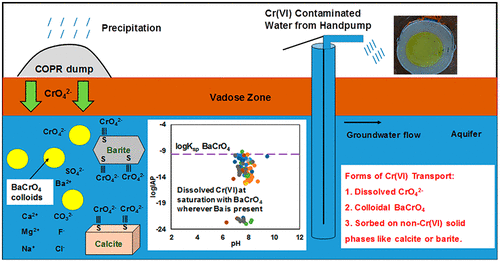当前位置:
X-MOL 学术
›
ACS Earth Space Chem.
›
论文详情
Our official English website, www.x-mol.net, welcomes your
feedback! (Note: you will need to create a separate account there.)
Processes Governing Chromium Contamination of Groundwater and Soil from a Chromium Waste Source
ACS Earth and Space Chemistry ( IF 2.9 ) Pub Date : 2019-12-13 , DOI: 10.1021/acsearthspacechem.9b00223 Mainak Bhattacharya 1 , Amritanshu Shriwastav 1, 2 , Shrikant Bhole 1, 3 , Rahul Silori 1, 4 , Tim Mansfeldt 5 , Ruben Kretzschmar 6 , Abhas Singh 1
ACS Earth and Space Chemistry ( IF 2.9 ) Pub Date : 2019-12-13 , DOI: 10.1021/acsearthspacechem.9b00223 Mainak Bhattacharya 1 , Amritanshu Shriwastav 1, 2 , Shrikant Bhole 1, 3 , Rahul Silori 1, 4 , Tim Mansfeldt 5 , Ruben Kretzschmar 6 , Abhas Singh 1
Affiliation

|
Chromium (Cr) contamination of natural resources from unregulated disposal of pretanning industrial waste, chromite ore processing residue (COPR), is a serious environmental concern, especially in developing countries. Although there have been studies on COPR characterization, the fate and transport of chromium emanating from COPR remains poorly understood. In this study, processes governing Cr contamination in groundwater and soil near known COPR disposal sites were investigated. Field sampling of groundwater, irrigated soil, and COPR was conducted near Kanpur (India) to identify the extent and forms of chromium contamination. Both dissolved and suspended fractions of groundwater were analyzed to evaluate the presence of any Cr-containing colloids. At certain locations with elevated Cr levels, the saturation state of sampled groundwater was evaluated to be near equilibrium with respect to BaCrO4(s) through speciation modeling of wet chemical data. Colloidal forms of Cr, such as BaCrO4(s) or as Cr adsorbed on other non-Cr containing phases, were suggested through measured differences in total and dissolved Cr concentrations and SEM-EDS evidence of Ba and Cr on filtrate residues. As BaCrO4(s) was not detected in COPR, the presence of these colloids in groundwater could be indicative of secondary precipitation of Cr upon interaction with Ba present in the subsurface. Rapid formation of colloidal BaCrO4(s) was also supported through controlled batch experiments with Cr(VI)- and Ba-spiked ultrapure water and groundwater. These results indicate the importance of secondary precipitation of colloidal BaCrO4(s) in determining eventual Cr(VI) solubility in aquifers impacted by Cr originating from COPR dissolution.
更新日期:2019-12-13











































 京公网安备 11010802027423号
京公网安备 11010802027423号